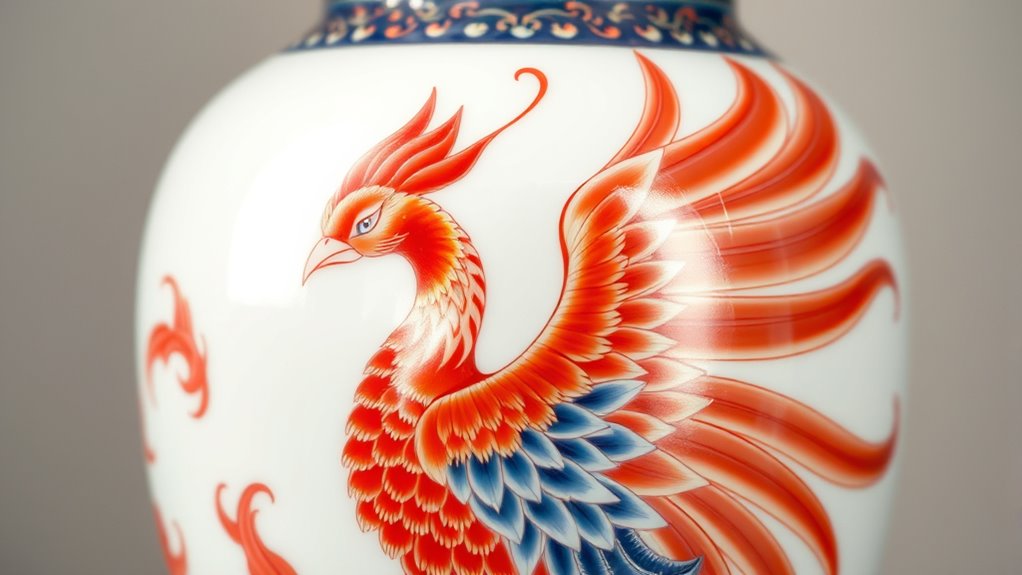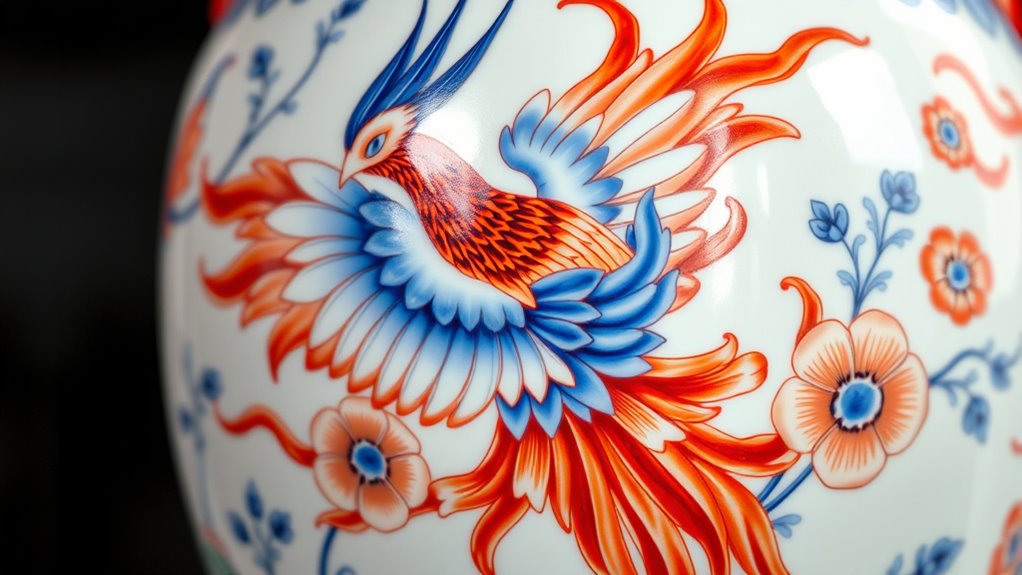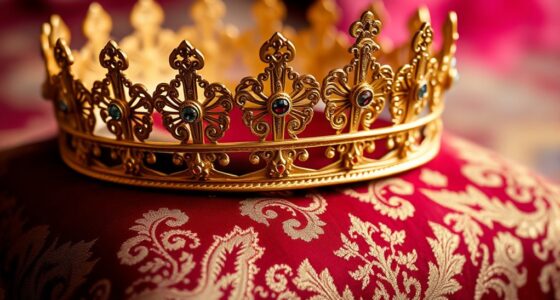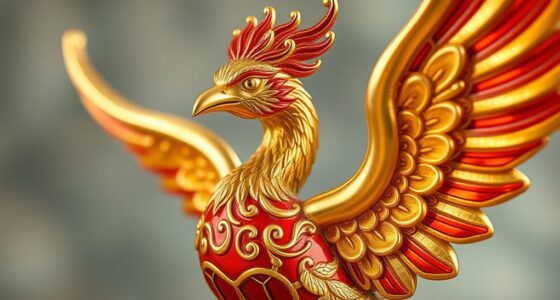You’ll see the phoenix in Chinese porcelain symbolize rebirth, immortality, and imperial power, often depicted with graceful, flowing feathers in vivid blue and white. Artisans masterfully capture its fiery crest and elegant movement, transforming the piece into a mythic story that reflects cultural beliefs about renewal and harmony. These designs elevate porcelain from mere decoration to a powerful emblem of Chinese mythology and heritage—if you explore further, you’ll uncover even deeper symbolic meanings behind this fiery motif.
Key Takeaways
- The phoenix symbolizes rebirth, immortality, and imperial authority in Chinese porcelain art.
- Blue and white porcelain vividly depicts phoenix feathers, emphasizing movement, vitality, and mythic symbolism.
- Artistic techniques include delicate brushwork and precise cobalt blue gradations, highlighting craftsmanship.
- The phoenix motif elevates porcelain from decoration to a vessel conveying cultural stories and divine power.
- Such porcelain embodies Chinese cultural heritage, connecting viewers to myths of renewal and spiritual rebirth.

The phoenix, a symbol of rebirth and immortality, has long been a prominent motif in Chinese porcelain. When you examine these exquisite pieces, you’ll notice that the phoenix isn’t just a decorative element—it embodies deep mythical symbolism that resonates with Chinese culture. It represents renewal, harmony, and the eternal cycle of life. This powerful imagery was often reserved for imperial ware, emphasizing the divine authority of the emperor, who was likened to the phoenix’s regal and virtuous qualities. As you explore the intricate designs, you’ll see that artisans used their mastery of artistic techniques to bring this mythic creature vividly to life. The delicate brushwork, precise outlines, and subtle gradations of blue ink on white porcelain showcase their skill. These artistic techniques weren’t just about aesthetics; they carried symbolic weight, elevating the phoenix from mere decoration to a vessel of cultural meaning.
In traditional Chinese porcelain, the depiction of the phoenix follows specific stylistic conventions. You’ll observe that the bird is often portrayed with elongated, flowing feathers, symbolizing grace and beauty. Its fiery crest and tail feathers are rendered with fine brushstrokes that suggest movement and vitality. The artisans employed underglaze blue painting, a technique that allowed for detailed, durable designs, which contributed to the porcelain’s prestige. The blue and white palette itself became a hallmark of Chinese porcelain, drawing attention to the craftsmanship behind each piece. Every stroke of the brush was deliberate, capturing the mythic symbolism of the phoenix—its role as a herald of prosperity and renewal.
As you appreciate these artworks, remember that the artistic techniques used weren’t just about creating a visually stunning object. They were imbued with meaning, transforming everyday porcelain into a narrative of myth and history. The mastery of manipulating cobalt blue pigment, the precision of the kiln firing process, and the careful planning of each design all serve to elevate the phoenix motif into a symbol of divine power and spiritual rebirth. Through these artistic choices, Chinese artisans conveyed complex stories and beliefs, making each piece a tangible connection to their rich cultural mythology. So, when you hold a piece of blue and white porcelain featuring the phoenix, you’re holding more than just ceramic—you’re holding a story of mythic symbolism, artistic ingenuity, and cultural legacy.
Frequently Asked Questions
What Is the Historical Significance of Phoenix Motifs in Chinese Culture?
You should recognize that phoenix motifs in Chinese culture symbolize mythological symbolism and imperial power. As an imperial emblem, the phoenix represents grace, virtue, and rebirth, often associated with the Empress and harmony in the cosmos. These motifs reflect deep cultural values and status, making them significant in art and ceramics. Their enduring presence highlights the phoenix’s role as a powerful symbol of renewal and auspiciousness throughout Chinese history.
How Are Phoenix Designs Created on Traditional Chinese Porcelain?
Perfecting porcelain’s picturesque phoenix patterns involves precise crafting techniques that blend tradition with artistry. Artists first sketch the phoenix’s elegant form, then meticulously apply cobalt blue underglaze using fine brushes. Once fired, the design’s detailed lines and vibrant hues emerge, embodying artistic symbolism of renewal and rebirth. This process transforms simple clay into stunning, symbolic ceramic masterpieces, showcasing craftsmanship’s essential role in creating mesmerizing, culturally rich porcelain designs.
What Are the Differences Between Phoenix Depictions in Ming and Qing Dynasty Ceramics?
You’ll notice that phoenix depictions in Ming and Qing dynasty ceramics differ in symbolism evolution and artistic techniques. Ming phoenix designs often appear more stylized, emphasizing auspicious symbolism with intricate, detailed patterns. Qing pieces tend to be more naturalistic, showcasing softer lines and vibrant colors. These changes reflect evolving artistic techniques and cultural meanings, making each period’s phoenix unique and rich in historical significance.
Are There Specific Regions in China Known for Phoenix-Themed Porcelain?
You’ll find phoenix-themed porcelain mainly from regions like Jingdezhen, known as China’s porcelain capital. Regional artisans here use advanced decorative techniques, such as underglaze blue and intricate painting, to craft stunning phoenix motifs. These areas have a long tradition of producing high-quality ceramics with detailed phoenix designs, symbolizing rebirth and prosperity. Their distinctive styles reflect local craftsmanship and cultural significance, making their porcelain highly prized worldwide.
How Rare Are Authentic Antique Phoenix Porcelain Pieces Today?
You might find authentic antique phoenix porcelain quite rare in today’s collectible market, especially if it’s in excellent condition. Many pieces have undergone restoration techniques to preserve their beauty, which can affect their value. Genuine antiques are highly sought after, making them a precious find. Keep an eye on reputable dealers, and remember that the rarity of these pieces adds to their allure and worth.
Conclusion
As you gaze at the intricate blue and white porcelain, the phoenix seems to stir, its fiery feathers almost alive, waiting to take flight. You can almost feel the heat of its rebirth, a symbol of renewal and eternity. But what secrets does this ancient creature hold beneath its delicate surface? The story isn’t over yet—you sense that behind every brushstroke lies a mystery, a fiery tale just waiting for you to uncover its next chapter.











